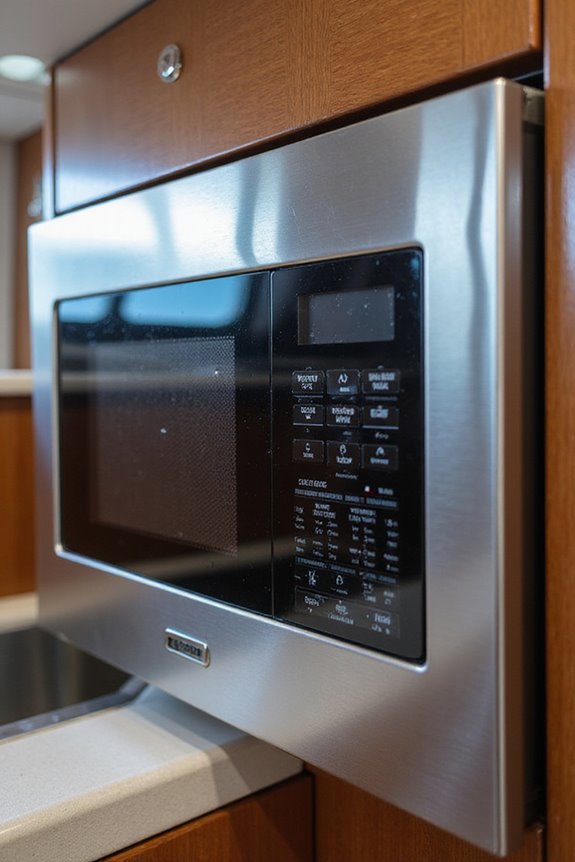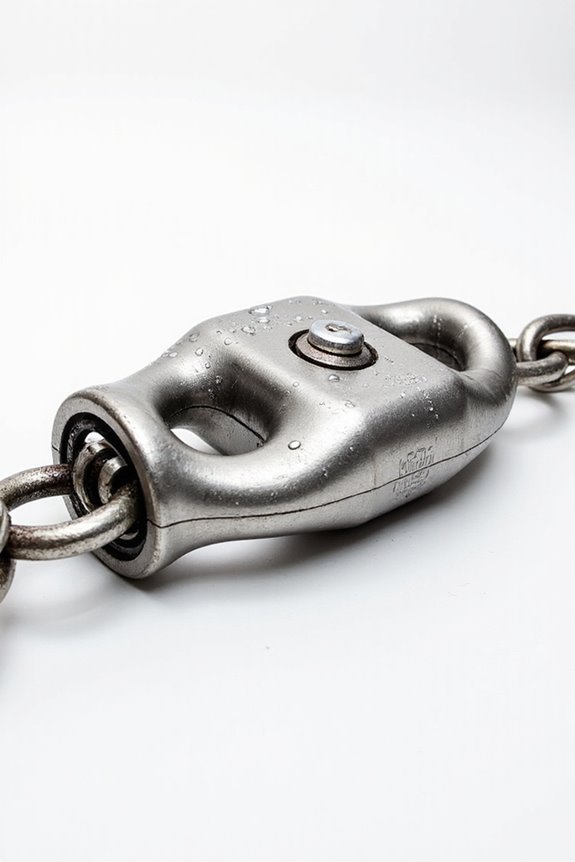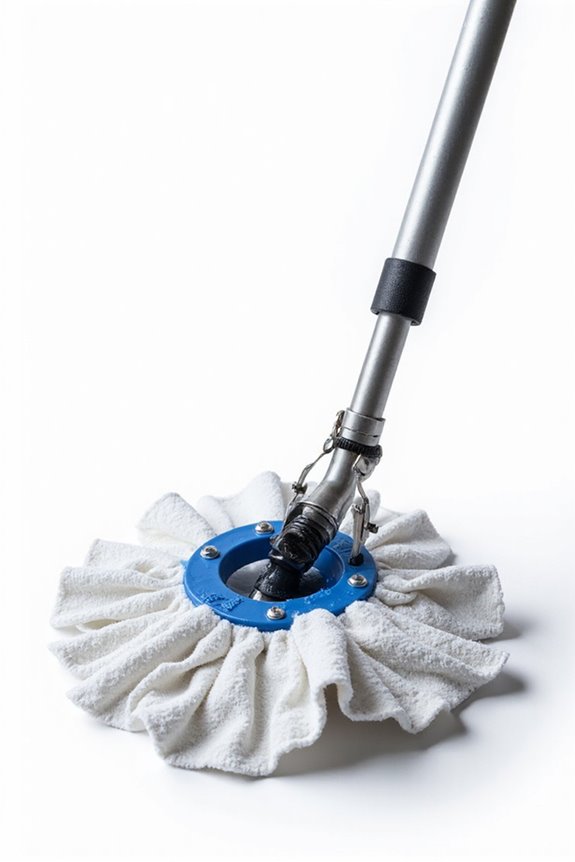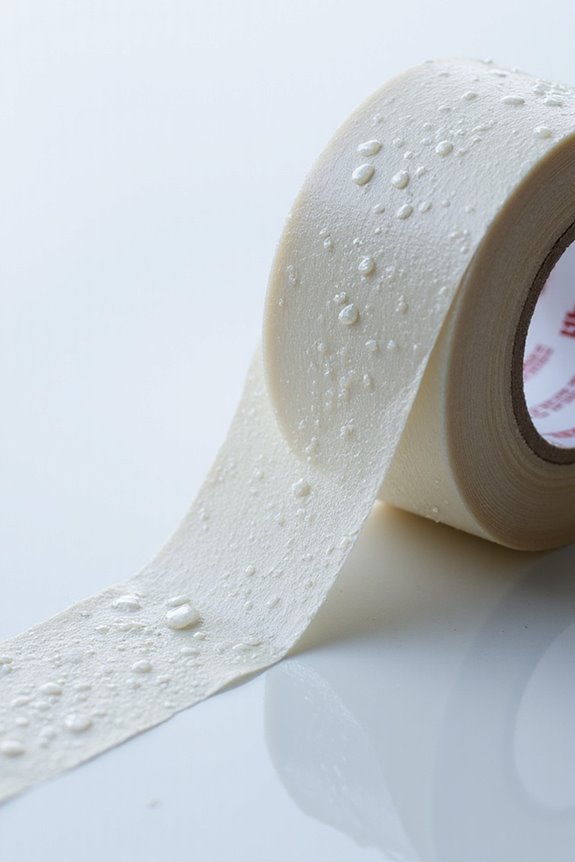We get it—choosing the right microwave for your boat isn’t just about popping popcorn. Marine grade microwaves are built tough to handle salt air, vibrations, and those tricky power surges from your onboard system. They’re compact, often stainless steel, and safe, fitting snugly in tight galleys while running efficiently on 230 V AC at 60 Hz. Plus, programmable features make cooking a breeze on the open water. Curious how they really make boat life easier?
Key Takeaways
- Marine-grade microwaves offer corrosion resistance against salty sea air, ensuring long-lasting durability on boats.
- Designed compactly to fit tight galleys, these microwaves save space and integrate seamlessly within boat kitchens.
- They operate safely on 230 V AC at 60 Hz and withstand voltage surges from boat power systems.
- Stainless steel construction resists dents, vibrations, and facilitates easy cleaning amidst marine conditions.
- Programmable controls and multiple memory settings enhance ease of use during meal preparation at sea.
Power and Performance Requirements for Marine Microwaves
When we’re talking about power and performance requirements for marine microwaves, it’s easy to overlook just how unique these little cooking marvels need to be for life at sea. It is understood that power efficiency isn’t just a buzzword here—it’s a lifeline, helping us manage limited onboard power without draining batteries too fast. Ever noticed how microwaves can demand a bigger jolt when starting up? Those startup loads often surge beyond regular running wattage, meaning our inverters and generators have to handle these bursts without tripping out. So, choosing a marine microwave designed for 230 V AC at 60 Hz, with the right wattage and inverter compatibility, isn’t just smart—it’s essential for smooth sailing. After all, who wants a dead microwave halfway through reheating dinner?
Design and Size Adaptations for Boat Galleys
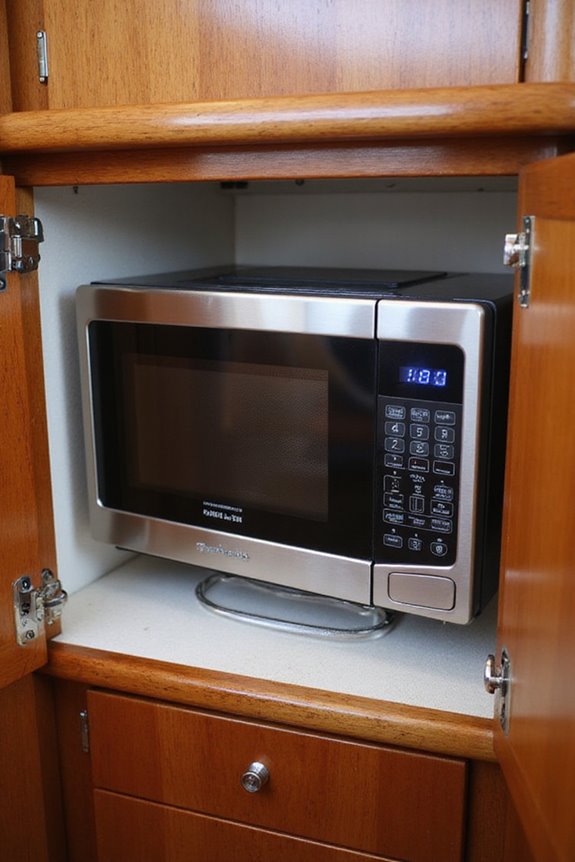
Since space on boats is as precious as fresh water, marine microwaves have to be clever with their design and size. They often sport compact designs that fit snugly into tight galleys, making the most of limited countertop real estate without cramping your style—or your cooking. Talk about galley integration: these microwaves can slide under or within countertops, blending seamlessly into your boat’s kitchenette. Some even ditch the turntable, saving space and reducing moving parts that might object to life at sea. Plus, with stainless steel construction, these microwaves stand up to saltwater and ship vibrations, so they’re not just small—they’re tough. So, if you want a microwave that’s as smart about space as you are, these design adaptations have you covered while you focus on smooth sailing and warm meals.
Electrical Compatibility and Safety Standards on Vessels
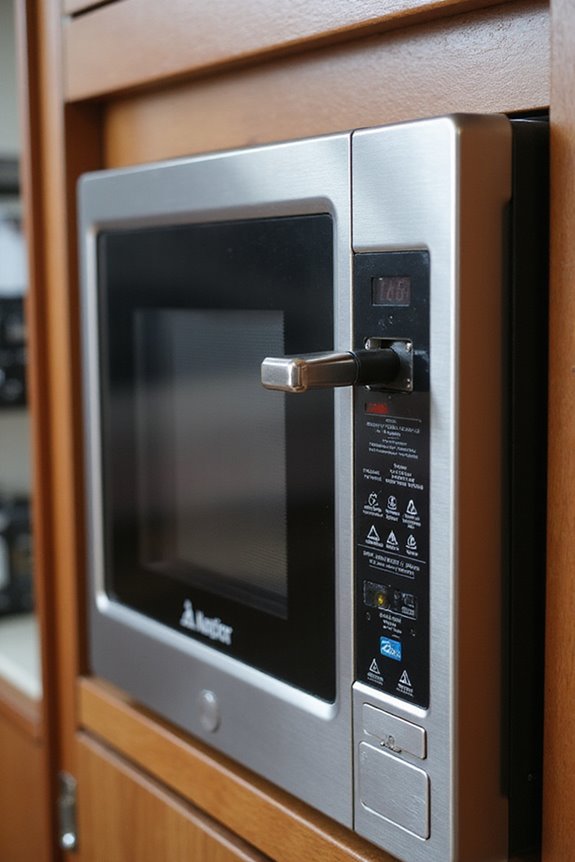
Although marine microwaves might seem like straightforward appliances, their electrical compatibility and safety on vessels demand a bit more attention than your average kitchen model. We need to think about wattage requirements carefully—most microwaves draw around 1200 watts and require a reliable power source, like a properly sized inverter or generator, to handle startup surges without hiccups. Plus, marine regulations aren’t just paperwork; they guarantee our appliances are insulated against moisture, and their electrical systems comply with safety standards. Ever wonder why some microwaves fizzle out on boats? Often, it’s unstable power or incompatible voltage. So, choosing the right marine-grade model that respects these rules keeps our galley running smoothly—and our nerves in check. After all, no one wants a short circuit to spice up their boating trip!
Programmable Controls and User-Friendly Features
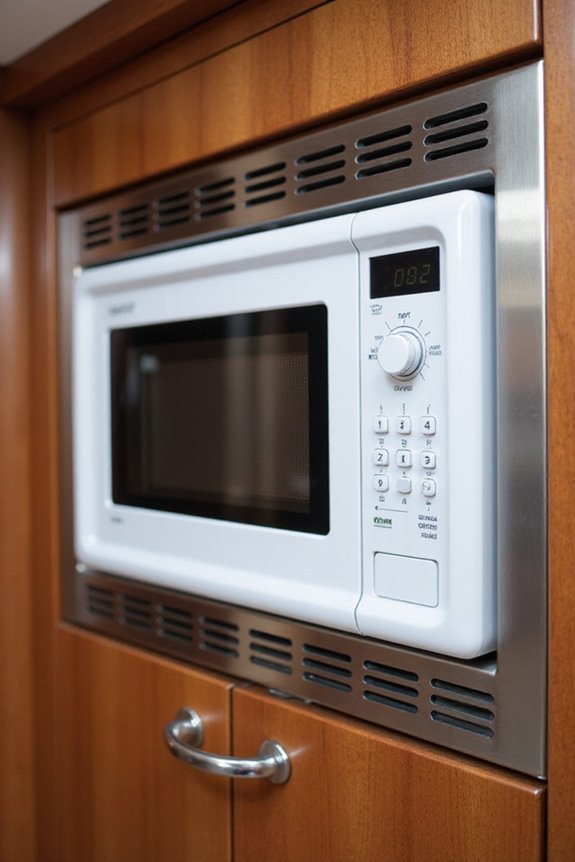
Ever wished your microwave could just remember exactly how you like your popcorn or reheat your coffee without fiddling with settings each time? That’s where programmable settings come in, turning your marine microwave into a smart kitchen buddy. With up to 10 memory pads and multi-stage cooking options, you can save your favorite power levels and times, so meals come out just right—every time. Plus, the user interface is designed to be straightforward, featuring digital controls, clocks, and timers that make operation simple, even on choppy seas. Instant start buttons and interior lighting add convenience, while features like the double quantity button mean less hassle for larger portions. Together, these user-friendly features make cooking aboard feel less like a chore and more like a breeze.
Advantages of Stainless Steel and Marine-Grade Materials
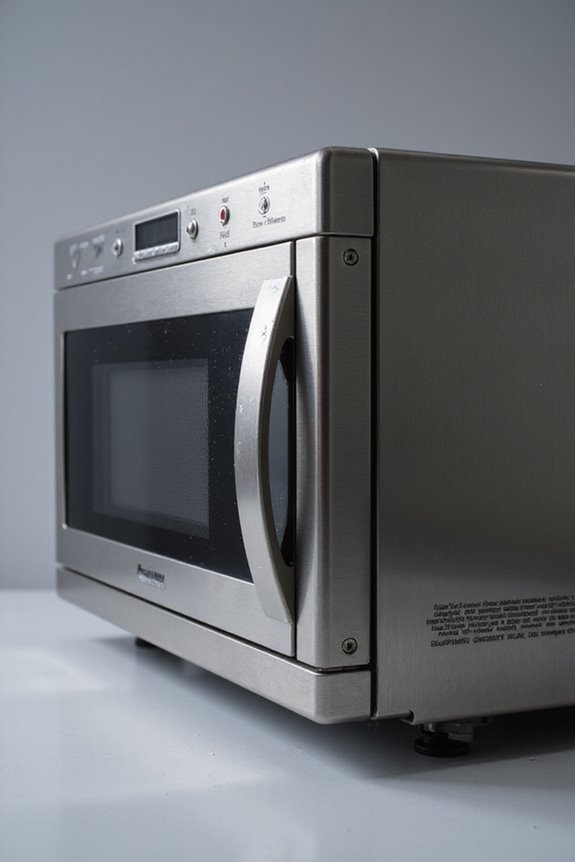
When it comes to marine microwaves, the materials used are as important as the tech inside them—think of stainless steel and marine-grade alloys as the unsung heroes keeping our appliances shipshape. These materials offer impressive corrosion resistance, essential to withstand salty sea air that loves to cause rust and pitting. Plus, they maintain their aesthetic appeal over time, keeping our galley looking sharp despite harsh conditions. Don’t we all appreciate a microwave that’s as tough as our adventurous spirit? Beyond beauty, marine-grade metals resist dents and vibrations—great for those choppy waters—and handle heat and UV exposure like champs. Their smooth surfaces make cleaning less of a chore, too. Bottom line: choosing the right materials means less upkeep and more time enjoying your voyage.
Safe Installation and Integration in Marine Interiors
We’ve talked about how marine-grade materials help your microwave stand up to salty air and boat life, but installing one on a boat isn’t as simple as just plugging it in. Facing installation challenges, we need to secure the microwave firmly—think sturdy brackets and straps—to handle rough seas without turning your snack prep into a game of catch. Safety precautions are a must, especially with wiring: dedicated circuits, proper fuses, and moisture-resistant components keep the sparks where they belong. Ventilation often gets overlooked but is key; without good airflow, that oven combo can overheat faster than you can say “popcorn.” Remember, following marine guidelines and regular maintenances might feel like extra work, but it’s the best way we keep our galley—and crew—safe and sound.
Choosing the Right Microwave for Your Marine Cooking Needs
How do you pick the right microwave for cooking aboard your boat without turning your galley into a cramped science lab? First, consider cooking efficiency—choose a model with adjustable power levels, so you’re not always blasting full blast and wasting energy. Size matters too; compact units with around 0.7 cu. ft. capacity fit tight spaces better but still handle most meals. Don’t forget installation tips! Make sure it matches your boat’s electrical specs and securely mounts to withstand waves. Stainless steel interiors resist corrosion and simplify cleaning, which we all appreciate after a long day on water. Bonus points if it has programmable settings for your favorite meals—makes cooking both quicker and stress-free. Ultimately, picking the right marine microwave means balancing power, size, and reliability so your galley feels just right.
Frequently Asked Questions
Can Marine Microwaves Operate on Both 120V and 230V Systems Interchangeably?
We understand power compatibility matters to us all. Some marine microwaves do meet voltage requirements for both 120V and 230V, letting us switch easily. But others need converters, so let’s always double-check before buying.
How Do Marine Microwaves Handle Salt Spray and Humidity Over Time?
We recognize that salt corrosion and humidity resistance are top concerns. That’s why we guarantee our microwaves use sealed components and specialized coatings, helping us all enjoy long-lasting, reliable performance even in harsh marine environments.
Are There Specific Cleaning Products Safe for Stainless Steel Marine Microwaves?
We’ve all worried about ruining our prized stainless steel appliances—but fear not! For marine appliance maintenance, mild soaps, Cerama Bryte stainless steel cleaners, and microfiber cloths keep surfaces pristine without harsh damage. We’re in this together.
Do Marine Microwaves Require Special Ventilation Compared to Household Models?
We understand you’re curious about ventilation requirements, and yes, marine microwaves need better air circulation than household ones. In tight spaces, proper airflow is essential to keep things safe and comfy for all of us onboard.
Can I Use Standard Microwave Cookware in a Marine-Grade Microwave?
Like sailors trusting their compass, we rely on microwave safety and cookware materials. We can use standard microwave cookware in marine-grade microwaves if they meet safety standards, ensuring our shared journey stays smooth and secure onboard together.

